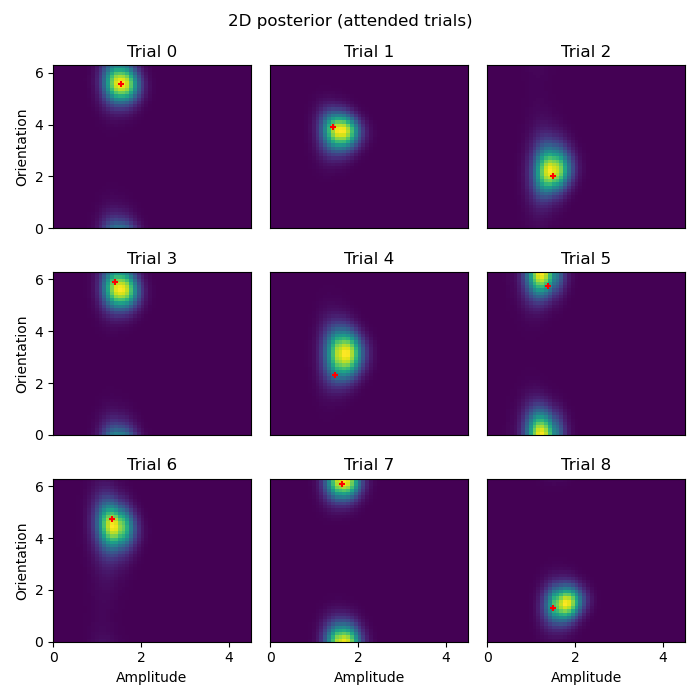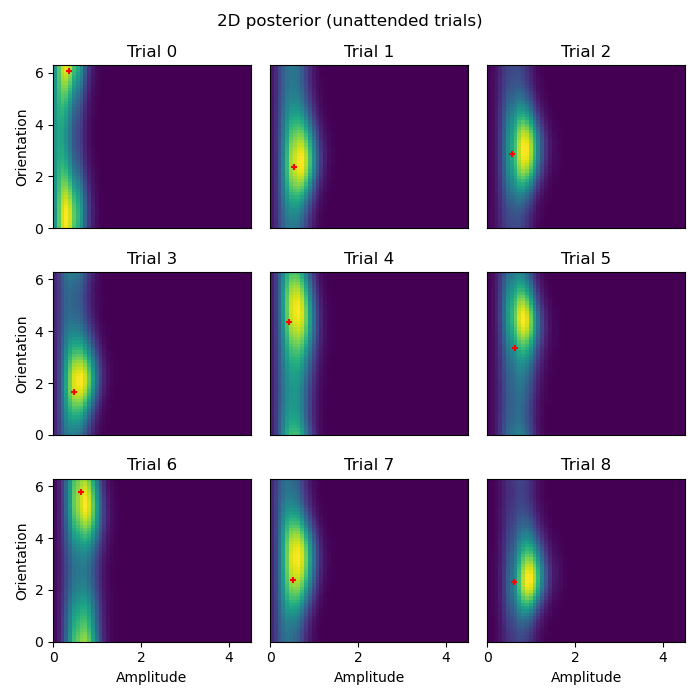Note
Go to the end to download the full example code
Decoding 2D stimuli from neural data#
Here, we are decoding oriented stimuli from neural data that have an extra dimension: amplitude.
Amplitude can be interpreted as the stimulus drive and has been shown to be modulated by cognitive effects such as expectation and attention.
# Set up a neural model
from braincoder.models import VonMisesPRF
import numpy as np
import pandas as pd
import scipy.stats as ss
noise = 0.5
# We are setting up a VonMisesPRF model with 8 orientations,
# We have 8 voxels, each with a linear combination of the 8 von Mises functions
# We use the identity matrix with some noice, so that each voxel is driven by
# largely by a single PRF
parameters = pd.DataFrame({'mu':np.linspace(0, 2*np.pi, 8, False), 'kappa':1.0, 'amplitude':1.0, 'baseline':0.0})
weights = np.identity(8) * 5.0
weights += np.random.rand(8, 8)
model = VonMisesPRF(parameters=parameters, model_stimulus_amplitude=True, weights=weights)
# Note how the stimulus type is now `OneDimensionalRadialStimulusWithAmplitude`
# which means that the stimulus is two-dimensional
print(model.stimulus)
print(model.stimulus.dimension_labels)
<braincoder.stimuli.OneDimensionalRadialStimulusWithAmplitude object at 0x2d2b6dd20>
['x (radians)', 'amplitude']
# Now we can simulate some data and estimate parameters+noise
mapper_paradigm = pd.DataFrame({'x (radians)':np.random.rand(100)*2*np.pi, 'amplitude':1.})
data = model.simulate(paradigm=mapper_paradigm, noise=noise)
# Set up parameter fitter
from braincoder.optimize import WeightFitter, ResidualFitter
fitter = WeightFitter(model, parameters, data, mapper_paradigm)
# With 8 overlapping Von Mises functions, we already need some regularisation, hence alpha=1.0
fitted_weights = fitter.fit(alpha=1.0)
# Now we fit the covariance matrix on the residuals
resid_fitter = ResidualFitter(model, data, mapper_paradigm, parameters, fitted_weights)
omega, dof = resid_fitter.fit(progressbar=False)
init_tau: 0.47485795617103577, 0.5606476664543152
WWT max: 16.49216651916504
# Now we set up an experimental paradigm with two conditions
# An `attended` and an `unattended` condition.
# In the attended condition, the stimulus will have more drive (1.5),
# in the unattended condition, the stimulus will have less drive (0.5).
n = 200
experimental_paradigm = pd.DataFrame(index=pd.MultiIndex.from_product([np.arange(n/2.), ['attended', 'unattended']], names=['frame', 'condition']))
# Random orientations
experimental_paradigm['x (radians)'] = np.random.rand(n)*2*np.pi
# Amplitudes have some noise
experimental_paradigm['amplitude'] = np.where(experimental_paradigm.index.get_level_values('condition') == 'attended', ss.norm(1.5, 0.1).rvs(n), ss.norm(.5, 0.1).rvs(n))
experimental_data = model.simulate(paradigm=experimental_paradigm, noise=noise)
# Plot the data
import seaborn as sns
import matplotlib.pyplot as plt
tmp = experimental_data.set_index(experimental_paradigm['x (radians)'], append=True).stack().to_frame('activity')
g = sns.FacetGrid(tmp.reset_index(), col='unit', col_wrap=4, hue='condition', palette='coolwarm_r')
g.map(plt.scatter, 'x (radians)', 'activity', alpha=0.85)
g.add_legend()
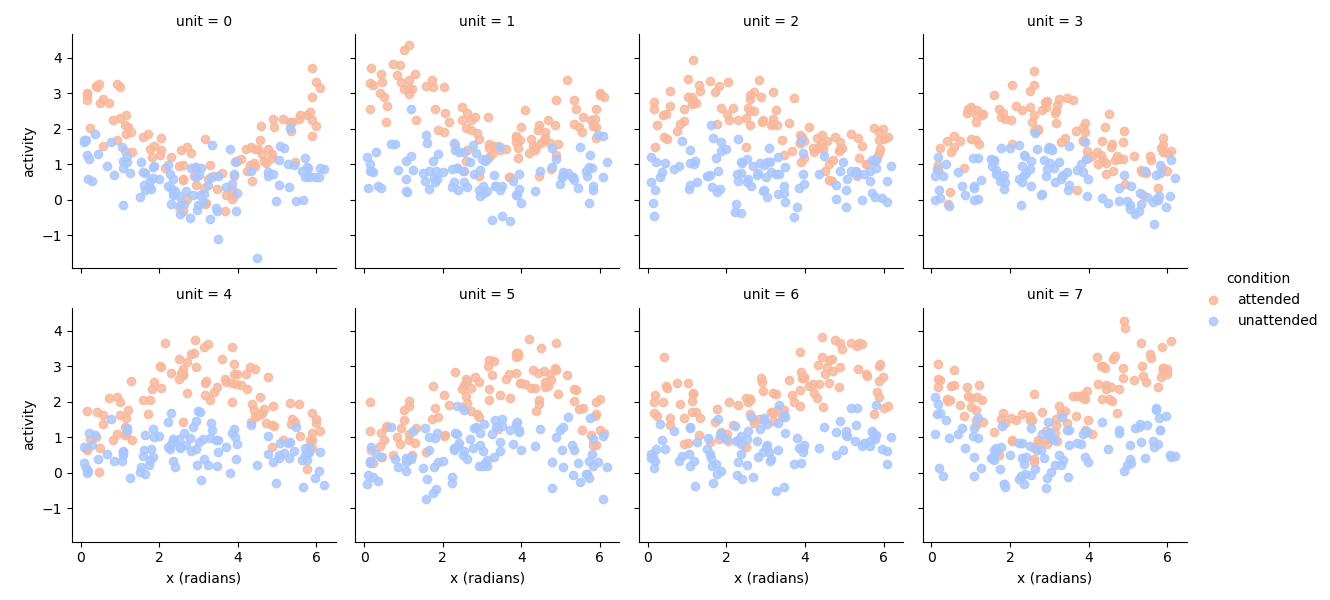
<seaborn.axisgrid.FacetGrid object at 0x2d94f8d30>
# Now we can calculate the 2D likelihood/posterior of different orientations+amplitudes for the data
lower_amplitude, higher_amplitude = 0.0, 4.5
potential_amplitudes = np.linspace(lower_amplitude, higher_amplitude, 50)
potential_orientations = np.linspace(0, 2*np.pi, 50, False)
# Make sure ground truth is the potential stimuli
potential_amplitudes = np.sort(np.append(potential_amplitudes, [0.5, 1.5]))
# We use the `pd.MultiIndex.from_product` function to create a grid of possible stimuli
potential_stimuli = pd.MultiIndex.from_product([potential_orientations, potential_amplitudes], names=['x (radians)', 'amplitude']).to_frame(index=False)
# Now we get, for each data point, the likelihood of each possible stimulus
ll = model.get_stimulus_pdf(experimental_data, potential_stimuli)
# Plot 2D posteriors for first 9 trials
# Once we have these 2D likelihoods, now we want to be able to plot them.
def plot_trial(key, ll=ll, paradigm=experimental_paradigm, xlabel=False, ylabel=False):
# We use the `stack` method to turn the `amplitude` dimension into a column
ll = ll.loc[key].unstack('amplitude')
# Use imshow to show a 2D image of the likelihood
vmin, vmax = ll.min().min(), ll.max().max()
plt.imshow(ll, origin='lower', aspect='auto', extent=[lower_amplitude, higher_amplitude, 0, 2*np.pi], vmin=vmin, vmax=vmax)
# Plot the _actual_ ground truth amplitude and orientation
plt.scatter(paradigm.loc[key]['amplitude'], paradigm.loc[key]['x (radians)'], c='r', s=25, marker='+')
# Some housekeeping for the subplots
plt.title(f'Trial {key[0]}')
if xlabel:
plt.xticks()
plt.xlabel('Amplitude')
else:
plt.xticks([])
if ylabel:
plt.yticks()
plt.ylabel('Orientation')
else:
plt.yticks([])
def plot_condition(condition):
"""
Plot the 2D posterior for a given condition for the first 9 trials.
Parameters:
condition (str): The condition for which to plot the posterior.
Returns:
None
"""
plt.figure(figsize=(7, 7))
for ix in range(9):
plt.subplot(3, 3, ix+1)
xlabel = ix in [6, 7, 8]
ylabel = ix in [0, 3, 6]
plot_trial((ix, condition), xlabel=xlabel, ylabel=ylabel)
plt.suptitle(f'2D posterior ({condition} trials)')
plt.tight_layout()
plot_condition('attended')
plot_condition('unattended')
# Now we can calculate the 1D posterior for specific orientations _or_ amplitudes
# Marginalize out orientations
amplitudes_posterior = ll.groupby('amplitude', axis=1).sum()
amplitudes_posterior = amplitudes_posterior.div(np.trapz(amplitudes_posterior, amplitudes_posterior.columns, axis=1), axis=0) # This is the same as normalizing the posterior
# Marginalize out amplitudes
orientations_posterior = ll.groupby('x (radians)', axis=1).sum()
orientations_posterior = orientations_posterior.div(np.trapz(orientations_posterior, orientations_posterior.columns, axis=1), axis=0)
# Plot orientation posteriors
tmp = orientations_posterior.stack().loc[:8].to_frame('p')
g = sns.FacetGrid(tmp.reset_index(), col='frame', col_wrap=3, hue='condition', palette='coolwarm_r')
g.map(plt.plot, 'x (radians)', 'p', alpha=0.85)
g.map(plt.axvline, x=1.5, c=sns.color_palette('coolwarm_r', 2)[0], ls='--')
g.map(plt.axvline, x=0.5, c=sns.color_palette('coolwarm_r', 2)[1], ls='--')
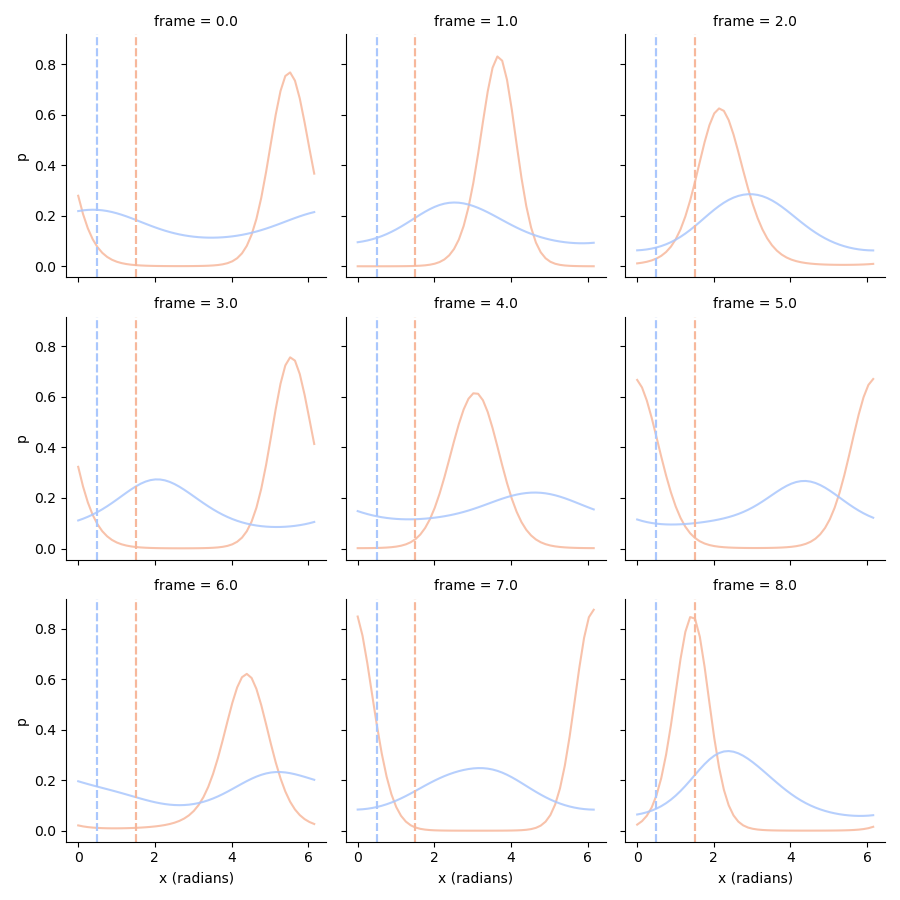
/Users/gdehol/git/braincoder/examples/00_encodingdecoding/decode2d.py:156: FutureWarning: DataFrame.groupby with axis=1 is deprecated. Do `frame.T.groupby(...)` without axis instead.
amplitudes_posterior = ll.groupby('amplitude', axis=1).sum()
/Users/gdehol/git/braincoder/examples/00_encodingdecoding/decode2d.py:160: FutureWarning: DataFrame.groupby with axis=1 is deprecated. Do `frame.T.groupby(...)` without axis instead.
orientations_posterior = ll.groupby('x (radians)', axis=1).sum()
<seaborn.axisgrid.FacetGrid object at 0x2d447f5b0>
# Use the ground truth amplitude to improve the orientation posterior
# so p(orientation|true_amplitude)
conditional_orientation_ll = pd.concat((ll.stack().xs('attended', 0, 'condition').xs(1.5, 0, 'amplitude'),
ll.stack().xs('unattended', 0, 'condition').xs(0.5, 0, 'amplitude')),
axis=0,
keys=['attended', 'unattended'],
names=['condition']).swaplevel(0, 1).sort_index()
# Normalize!
conditional_orientation_ll = conditional_orientation_ll.div(np.trapz(conditional_orientation_ll, conditional_orientation_ll.columns, axis=1), axis=0)
tmp = conditional_orientation_ll.stack().loc[:8].to_frame('p')
g = sns.FacetGrid(tmp.reset_index(), col='frame', col_wrap=3, hue='condition', palette='coolwarm_r')
g.map(plt.plot, 'x (radians)', 'p', alpha=0.85)
g.map(plt.axvline, x=1.5, c=sns.color_palette('coolwarm_r', 2)[0], ls='--')
g.map(plt.axvline, x=0.5, c=sns.color_palette('coolwarm_r', 2)[1], ls='--')
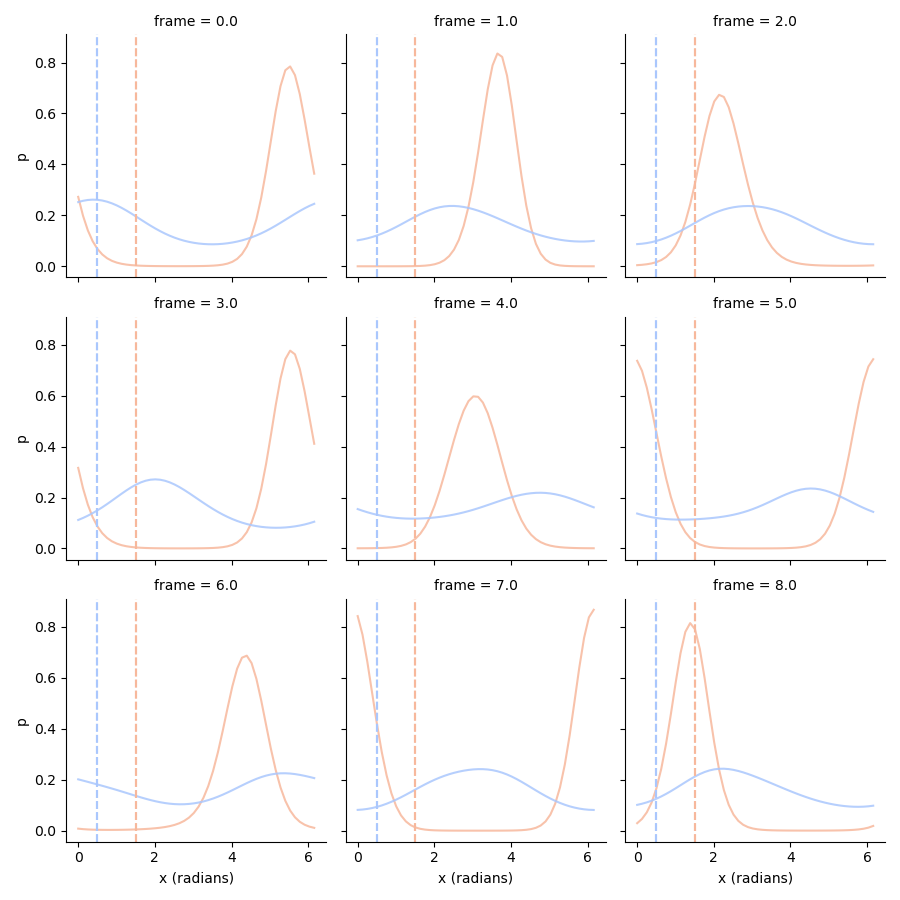
<seaborn.axisgrid.FacetGrid object at 0x2d09b9930>
# Intro to complex numbers
def to_complex(x):
return np.exp(1j*x)
def from_complex(x):
x = np.angle(x)
return np.where(x < 0, x + 2*np.pi, x)
# Let's plot the firs 10 trials in the complex plane
first_10_trials = experimental_paradigm.xs('attended', 0, 'condition')['x (radians)'].iloc[:10]
orientations_complex = to_complex(first_10_trials.values)
plt.figure()
plt.scatter(orientations_complex.real, orientations_complex.imag, c=first_10_trials.index)
plt.gca().set_aspect('equal')
plt.xlabel('Real')
plt.ylabel('Imaginary')
sns.despine()
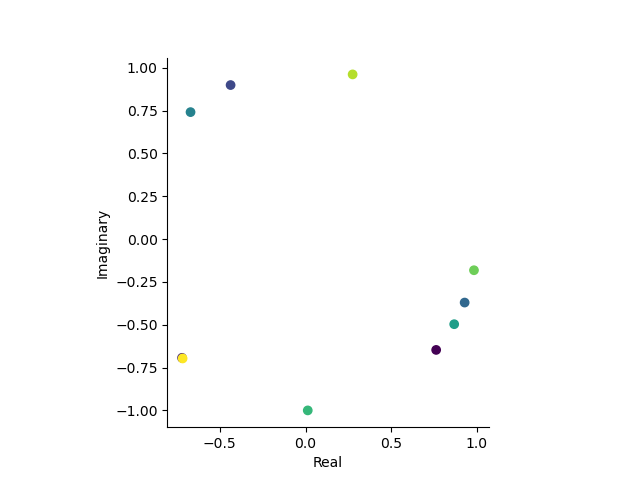
# Get posterior means by integrating over complex numbers
def wrap_angle(x):
return np.mod(x + np.pi, 2*np.pi) - np.pi
def get_posterior_stats(posterior, ground_truth=None):
posterior = posterior.copy()
complex_grid = np.asarray(to_complex(posterior.columns))
# Take integral over the posterior to get to the expectation (mean posterior)
# In this case a complex number that we convert back to an angle between 0 and 2pi
E = from_complex(np.trapz(posterior*complex_grid[np.newaxis,:], axis=1))
# Take the integral over the posterior to get the expectation of the distance to the
# mean posterior (i.e., standard deviation)
relative_error = E[:, np.newaxis] - posterior.columns.values[np.newaxis,:]
# Wrap the angle to be between 0 and pi, the error can never be larger than pi (180 degrees)
relative_error = wrap_angle(relative_error)
absolute_error = np.abs(relative_error)
sd = np.trapz(absolute_error * posterior, posterior.columns, axis=1)
stats = pd.DataFrame({'E':E, 'sd':sd}, index=posterior.index)
if ground_truth is not None:
stats['E_error'] = wrap_angle(stats['E'] - ground_truth)
stats['E_error_abs'] = np.abs(stats['E_error'])
stats['ground_truth'] = ground_truth
return stats
posterior_stats = get_posterior_stats(conditional_orientation_ll, ground_truth=experimental_paradigm['x (radians)'].values)
# Circular correlations:
import pingouin as pg
posterior_stats.groupby('condition').apply(lambda d: pd.Series(pg.circ_corrcc(d['E'], d['ground_truth'], True), index=['rho', 'p']))
# Let's see how far the posterior mean is from the ground truth
# by plotting the estimates and groun truth in the complex plane
palette = sns.color_palette('coolwarm_r', 2)
# Create custom legend
legend_elements = [
plt.Line2D([0], [0], marker='x', color='k', label='Estimate', markersize=8, linewidth=0),
plt.Line2D([0], [0], marker='o', color='k', label='Truth', markersize=8, linewidth=0),
plt.Line2D([0], [0], marker='s', color=palette[0], label='Attended', markersize=8, linewidth=0),
plt.Line2D([0], [0], marker='s', color=palette[1], label='Unattended', markersize=8, linewidth=0)
]
# Plot the data
for ix, row in posterior_stats.iloc[:10].iterrows():
hue = sns.color_palette('coolwarm_r', 2)[['attended', 'unattended'].index(ix[1])]
estimate_complex = to_complex(row['E'])
ground_truth_complex = to_complex(row['ground_truth'])
plt.plot([estimate_complex.real, ground_truth_complex.real], [estimate_complex.imag, ground_truth_complex.imag], color=hue)
plt.scatter(estimate_complex.real, estimate_complex.imag, color=hue, s=50, marker='x')
plt.scatter(ground_truth_complex.real, ground_truth_complex.imag, color=hue, s=50, marker='o')
# Set aspect ratio and remove spines
plt.gca().set_aspect('equal')
sns.despine()
# Add legend
plt.legend(handles=legend_elements)
# Show the plot
plt.show()
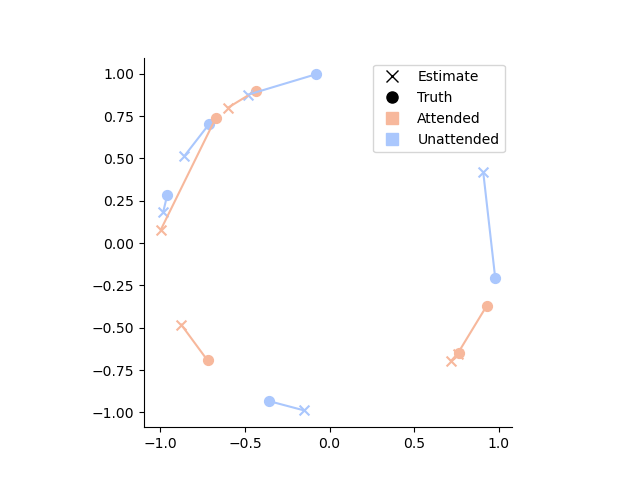
# Plot the error as a function of the standard deviation of the posterior
sns.lmplot(x='sd', y='E_error_abs', data=posterior_stats.reset_index(), hue='condition')
# %%
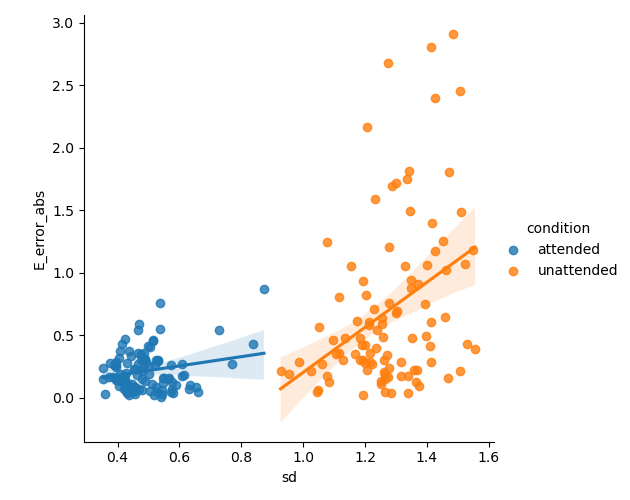
<seaborn.axisgrid.FacetGrid object at 0x2d14a65c0>
Total running time of the script: (0 minutes 7.677 seconds)
